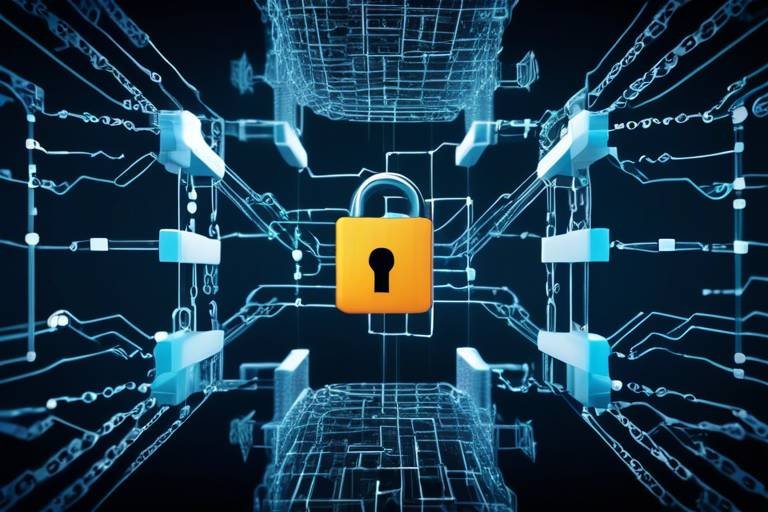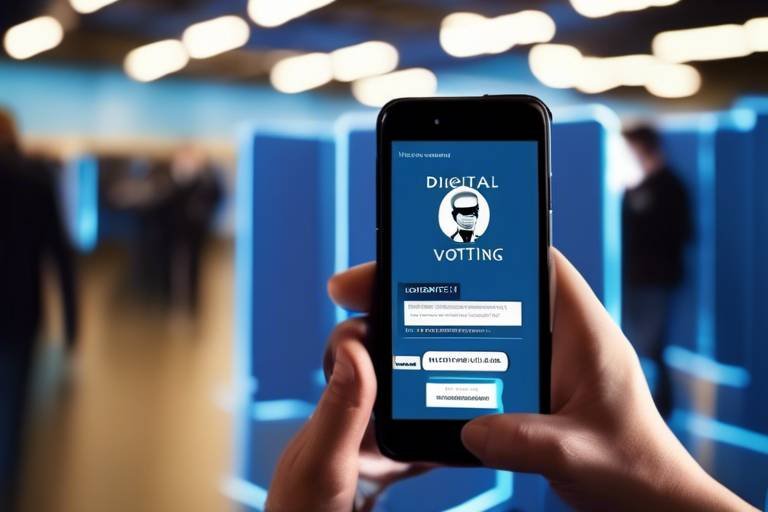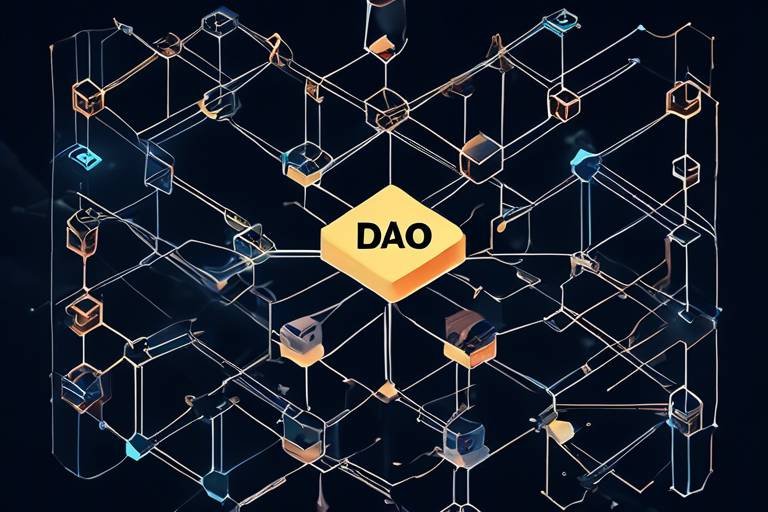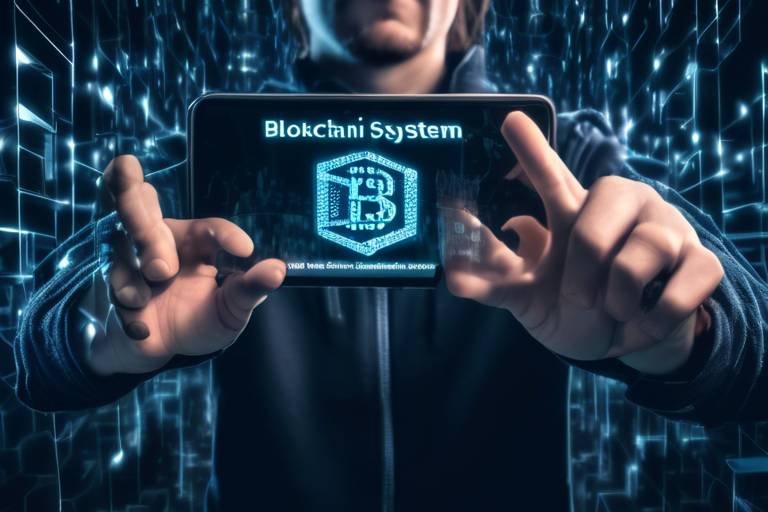Blockchain Technology in the Gaming Industry - The Rise of Play-to-Earn
In recent years, the gaming industry has undergone a seismic shift, largely driven by the advent of blockchain technology. This revolutionary tech has opened up new avenues for gamers, transforming how they interact with games and each other. The rise of play-to-earn (P2E) models has empowered players, allowing them to earn real-world value from their in-game achievements. Imagine a world where your gaming skills translate into tangible rewards—this is no longer just a fantasy; it's a reality, thanks to blockchain!
At its core, blockchain technology is all about decentralization, transparency, and security. Traditional gaming systems often rely on centralized servers, which can lead to issues like fraud, data breaches, and lack of player ownership. In contrast, blockchain offers a distributed ledger that ensures all transactions are recorded securely and transparently. This means that players can truly own their in-game assets, whether it's a rare sword, a unique character skin, or even virtual real estate. The implications of this shift are profound, not only for players but also for developers and the entire gaming ecosystem.
The play-to-earn model is a game-changer in the industry. Instead of merely spending money to play, gamers can now monetize their time and skills. Through various activities, such as completing quests, winning battles, or trading virtual items, players can earn cryptocurrency and other digital assets. This creates a symbiotic relationship where both players and developers benefit. Players enjoy engaging gameplay while earning rewards, and developers can attract a larger audience by offering innovative economic models.
As we dive deeper into the mechanics of play-to-earn, we’ll uncover how players can accumulate cryptocurrency and the vital role that non-fungible tokens (NFTs) play in this ecosystem. NFTs serve as proof of ownership for unique in-game items, opening up new markets and opportunities for players to trade and sell their assets. This not only enhances the gaming experience but also introduces a new layer of economic interaction among players.
Moreover, the concept of tokenomics—the economic model governing a game's currency—plays a crucial role in the success of play-to-earn games. A well-designed token economy can significantly enhance player engagement and retention, leading to a thriving gaming community. Developers are increasingly recognizing the potential profitability of these models, as they can create new revenue streams while keeping players invested in their games.
However, with great opportunity comes great responsibility. The integration of blockchain technology into gaming is not without its challenges. Issues such as market volatility, regulatory uncertainties, and security concerns must be addressed to ensure a safe and sustainable gaming environment. As the regulatory landscape evolves, developers and players alike must stay informed about the implications of these changes on the play-to-earn ecosystem.
In conclusion, the rise of blockchain technology and play-to-earn models is reshaping the gaming industry in ways we could only dream of a few years ago. As we look to the future, it’s clear that ongoing innovations will continue to influence how we play, earn, and interact within these virtual worlds. The journey has just begun, and the possibilities are endless!
- What is blockchain technology? - Blockchain is a decentralized digital ledger that securely records transactions across multiple computers, ensuring transparency and security.
- How do play-to-earn games work? - Players earn cryptocurrency and other digital assets by engaging in various in-game activities, such as completing quests or trading items.
- What are NFTs? - Non-fungible tokens (NFTs) are unique digital assets that represent ownership of specific in-game items, allowing players to trade and sell them.
- What are the risks of play-to-earn gaming? - Risks include market volatility, regulatory challenges, and security vulnerabilities that could affect players' assets and data.

The Basics of Blockchain Technology
Understanding blockchain technology is crucial for grasping its applications in gaming. At its core, blockchain is a decentralized digital ledger that records transactions across multiple computers. This means that no single entity has control over the entire chain, making it less susceptible to fraud and manipulation. Imagine a neighborhood where every house has a copy of the same book. Whenever someone writes a new chapter, all the houses update their books simultaneously. This is how blockchain works—everyone has a copy, and everyone must agree on the content.
One of the standout features of blockchain is its transparency. Each transaction is visible to all participants in the network, which fosters trust among users. You can think of it like a public scoreboard in a game; everyone can see the scores, and no one can cheat without being caught. This transparency is particularly important in gaming, where players often worry about fairness and integrity.
Another critical aspect is security. Blockchain uses cryptographic techniques to secure transactions and control the creation of new units. This makes it incredibly difficult for hackers to alter the data. In fact, changing any single block in the chain would require altering every subsequent block, which is nearly impossible without the consensus of the majority of the network. It's akin to trying to change the outcome of a sports match after it has been played; the evidence is already out there, and it would take an overwhelming amount of effort to alter it.
In the gaming industry, these principles of decentralization, transparency, and security are reshaping how games are developed and played. Developers are leveraging blockchain to create environments where players have true ownership of their in-game assets. Instead of being mere players, they become stakeholders in the gaming ecosystem. This shift is not just about technology; it’s about empowering players and creating a more equitable gaming landscape.
To summarize, the foundational elements of blockchain technology—decentralization, transparency, and security—are driving a revolution in the gaming industry. As we delve deeper into the play-to-earn models, it's essential to recognize how these principles enhance the gaming experience and provide real-world value to players.

Play-to-Earn Explained
Imagine a world where your gaming skills can actually put money in your pocket. Sounds like a dream, right? Well, welcome to the realm of play-to-earn (P2E) gaming! This revolutionary model has taken the gaming industry by storm, allowing players to earn real-world value from their in-game achievements. No longer are gaming experiences confined to mere entertainment; they now hold the potential for financial gain.
So, how does this all work? At its core, play-to-earn games leverage blockchain technology to create a transparent and decentralized environment. Players engage in a variety of activities, from completing quests to battling opponents, and in return, they receive rewards in the form of cryptocurrency or unique in-game assets. This system not only incentivizes players to invest time and effort into their gaming but also empowers them to take control of their virtual assets.
One of the standout features of play-to-earn models is the ability for players to convert their in-game earnings into real money. For example, players can earn tokens that can be traded on various cryptocurrency exchanges, allowing them to cash out their earnings. This creates a virtuous cycle—the more time and skill a player invests, the greater their potential rewards. It's like leveling up in a game, but instead of just gaining experience points, you're also gaining financial rewards!
Moreover, play-to-earn games often incorporate non-fungible tokens (NFTs), which represent ownership of unique in-game items. These NFTs can be anything from rare skins to virtual land, and they can be bought, sold, or traded among players. This not only enhances the gaming experience but also adds a layer of economic complexity that traditional gaming models lack. Players can truly own their assets, which can appreciate in value over time, similar to collecting rare items in the real world.
To give you a clearer picture, here’s a quick breakdown of how play-to-earn models typically function:
| Activity | Reward | Potential Earnings |
|---|---|---|
| Completing Quests | Tokens or NFTs | Varies based on game |
| Winning Battles | Cryptocurrency | Can be significant |
| Trading in-game items | Real money | Market-dependent |
As you can see, the opportunities for players are vast and varied. This model not only attracts hardcore gamers but also casual players who are looking to make a little extra cash while enjoying their favorite pastime. It’s a win-win situation that’s reshaping how we view gaming.
In summary, play-to-earn is not just a trend; it's a paradigm shift in the gaming industry. By allowing players to earn real-world value from their gaming experiences, it opens up a whole new world of possibilities. Whether you're a seasoned gamer or a newbie, the play-to-earn model invites everyone to join in on the fun—and profit!
- What is play-to-earn gaming? - Play-to-earn gaming allows players to earn real-world value through their in-game achievements, often in the form of cryptocurrency or NFTs.
- How do players earn money in these games? - Players can earn money by completing quests, winning battles, and trading in-game items for real money.
- What role do NFTs play in play-to-earn games? - NFTs represent ownership of unique in-game items, adding value and allowing players to trade or sell them.
- Is play-to-earn gaming safe? - While there are risks involved, such as market volatility, many developers are implementing security measures to protect players' assets.

How Players Earn Cryptocurrency
In the vibrant world of play-to-earn gaming, players can earn cryptocurrency through a variety of engaging activities that not only enhance their gaming experience but also provide tangible rewards. Imagine diving into a game where your skills and time investment translate into real-world value; that’s the magic of blockchain technology in action. Players can accumulate digital assets in several ways, each offering a unique path to earning.
One of the primary methods players use to earn cryptocurrency is through completing in-game quests and challenges. These tasks often require skill, strategy, and time, but the payoff can be substantial. For instance, a player might embark on a quest to defeat a formidable boss or gather rare resources, and upon completion, they are rewarded with tokens that hold value in the real world. This creates a thrilling incentive to explore the game’s universe and invest effort into mastering it.
Another popular avenue is through trading in-game items and assets on decentralized marketplaces. Players can buy, sell, or trade unique items they’ve earned or created, often using NFTs (Non-Fungible Tokens) to represent ownership. This not only allows players to profit from their in-game achievements but also fosters a vibrant economy within the game. For example, a player who has crafted a rare sword can sell it for cryptocurrency, thus monetizing their hard work and creativity.
Additionally, some games implement staking mechanisms where players can lock up their earned tokens in exchange for rewards. This method not only encourages players to hold onto their assets but also contributes to the overall stability and growth of the game’s economy. By staking their tokens, players can earn passive income, creating a win-win situation where they benefit while supporting the game's ecosystem.
Moreover, tournaments and competitive events are another exciting way for players to earn cryptocurrency. Many games host regular competitions where players can showcase their skills against others. The winners of these tournaments often receive substantial cryptocurrency prizes, further motivating players to improve their gameplay and engage more deeply with the community.
In summary, the ways players can earn cryptocurrency in play-to-earn games are as diverse as the games themselves. From completing quests and trading items to staking tokens and competing in tournaments, players have multiple avenues to turn their gaming passion into real-world financial rewards. As the play-to-earn model continues to evolve, it’s clear that the potential for earning cryptocurrency will only expand, making the gaming experience even more rewarding.
- What is play-to-earn gaming? Play-to-earn gaming refers to a model where players can earn real-world value, often in the form of cryptocurrency, by engaging in gameplay.
- How do players earn cryptocurrency? Players can earn cryptocurrency through completing quests, trading in-game items, staking tokens, and participating in tournaments.
- What are NFTs in gaming? NFTs are unique digital assets that represent ownership of in-game items, allowing players to buy, sell, and trade them on decentralized marketplaces.
- Are there risks associated with play-to-earn gaming? Yes, there are risks such as market volatility, regulatory issues, and security concerns that players should be aware of.

NFTs in Gaming
In the rapidly evolving landscape of gaming, Non-Fungible Tokens (NFTs) have emerged as a revolutionary element, fundamentally altering how players interact with in-game assets. Unlike traditional digital items, which can be easily duplicated and lack true ownership, NFTs are unique digital certificates that represent ownership of specific items or characters within a game. This uniqueness is what makes NFTs so appealing to gamers, creating a sense of scarcity and value that was previously absent in the gaming world.
Imagine a rare sword in a fantasy game. In the past, it might have been just another item that players could acquire, but with NFTs, that sword becomes a one-of-a-kind asset. Players can buy, sell, or trade their NFTs on various marketplaces, allowing them to realize real-world value from their in-game achievements. This shift not only enhances the gaming experience but also empowers players to take control of their digital assets in a way that wasn't possible before.
The integration of NFTs into gaming isn't just about ownership; it also opens up new avenues for creativity and customization. Players can create unique skins, outfits, or even entire worlds, which can then be tokenized as NFTs. This means that gamers can not only play but also contribute to the game’s ecosystem, potentially earning money in the process. For game developers, this creates opportunities for community engagement and new revenue streams through the sale of these digital assets.
However, the rise of NFTs in gaming is not without its challenges. Issues such as environmental concerns regarding blockchain technology and the volatility of NFT markets can pose risks for both players and developers. As the industry continues to evolve, it's crucial for stakeholders to address these challenges while maximizing the benefits that NFTs can bring to gaming.
In conclusion, NFTs represent a significant advancement in the gaming industry, providing players with genuine ownership of their in-game assets and creating new economic models that benefit both players and developers. As we move forward, the impact of NFTs on gaming will likely become even more pronounced, paving the way for a more engaging and rewarding gaming experience.

Tokenomics and Game Design
In the rapidly evolving world of play-to-earn gaming, tokenomics plays a pivotal role in shaping the overall player experience and game design. At its core, tokenomics refers to the economic model that governs the creation, distribution, and management of a game's currency. This currency can take various forms, including cryptocurrencies and in-game tokens, each serving unique purposes within the gaming ecosystem. By understanding how tokenomics works, developers can create engaging and sustainable gaming environments that not only attract players but also keep them invested over time.
One of the primary objectives of effective tokenomics is to establish a balanced economy that rewards players for their participation while ensuring the game's longevity. A well-designed tokenomics model can enhance player engagement by offering various incentives, such as:
- In-game rewards: Players earn tokens through gameplay achievements, which can be spent on upgrades, cosmetics, or even traded on external marketplaces.
- Staking options: By allowing players to stake their tokens, developers can create additional layers of engagement and reward players for their loyalty.
- Market dynamics: A dynamic in-game marketplace, where players can buy, sell, or trade their assets, adds an extra layer of excitement and competition.
Moreover, tokenomics can significantly influence game design. Developers must carefully consider how the in-game economy aligns with gameplay mechanics. For instance, if players can earn tokens too easily, it may lead to inflation, devaluing the currency and diminishing the overall gaming experience. On the other hand, if earning tokens is too difficult, players may become frustrated and disengage. Striking the right balance is essential for maintaining a healthy economic ecosystem within the game.
To illustrate the impact of tokenomics on game design, consider the following table that outlines key components and their effects:
| Tokenomics Component | Effect on Game Design |
|---|---|
| Reward Structure | Encourages player participation and retention through meaningful rewards. |
| Token Utility | Defines how tokens can be used within the game, influencing player strategies. |
| Marketplaces | Creates a player-driven economy that fosters competition and collaboration. |
| Scarcity Mechanics | Enhances the perceived value of tokens and in-game items, driving demand. |
In summary, the relationship between tokenomics and game design is intricate and essential for the success of play-to-earn games. Developers who prioritize thoughtful tokenomics can create engaging experiences that not only captivate players but also foster a thriving in-game economy. As the gaming landscape continues to evolve, staying ahead of tokenomics trends will be crucial for developers aiming to create the next big hit in the blockchain gaming space.
1. What is tokenomics?
Tokenomics refers to the economic model that governs the creation, distribution, and management of a game's currency, including cryptocurrencies and in-game tokens.
2. How does tokenomics impact game design?
Tokenomics influences game design by determining the reward structure, token utility, and market dynamics, which can enhance player engagement and retention.
3. What are the benefits of a well-designed tokenomics model?
A well-designed tokenomics model can create a balanced in-game economy, encourage player participation, and foster a vibrant marketplace for trading assets.
4. Why is balancing tokenomics important?
Balancing tokenomics is crucial to prevent inflation or deflation of in-game currencies, ensuring a sustainable and enjoyable gaming experience for players.

Benefits for Game Developers
As the gaming industry continues to evolve, game developers are finding themselves at the forefront of a revolutionary shift thanks to blockchain technology. One of the most exciting developments in this realm is the play-to-earn model, which not only enhances player engagement but also opens up new avenues for developers to monetize their creations. But what exactly are the benefits for developers in this new landscape?
First and foremost, the financial incentives associated with play-to-earn games are significant. By integrating blockchain technology, developers can create in-game economies that allow players to earn real-world value for their time and effort. This creates a win-win scenario where players are motivated to spend more time in the game, and developers can benefit from increased player retention and engagement. Imagine a world where your players are not just consumers but active participants in a thriving economy!
Moreover, the decentralized nature of blockchain enables developers to maintain greater control over their games. Unlike traditional gaming models, where publishers often take a large cut of the profits, blockchain allows for direct transactions between players and developers. This means that developers can establish their own revenue streams through the sale of in-game assets, NFTs, and even transaction fees, leading to potentially higher profits.
Another key advantage is the ability to create unique and tradable in-game assets. With the rise of non-fungible tokens (NFTs), developers can craft items that players can truly own and trade. This not only adds a layer of excitement to gameplay but also enables developers to engage with their communities in new ways. Players can buy, sell, or trade their unique items, creating a vibrant marketplace that can keep players coming back for more.
Furthermore, the integration of blockchain technology can enhance the trustworthiness of the gaming ecosystem. Players are more likely to engage with games that provide transparency regarding transactions and ownership. By leveraging blockchain's inherent features, developers can assure players that their investments in time and money are secure. This trust can lead to a more loyal player base, which is invaluable in an industry that thrives on community.
However, it’s essential to note that adopting play-to-earn models also requires developers to consider tokenomics—the economic structure surrounding their game's currency. A well-designed tokenomics model can lead to a balanced in-game economy that benefits both players and developers. By understanding how to structure their in-game currencies, developers can ensure sustainable growth and engagement.
In summary, the benefits for game developers embracing blockchain and play-to-earn models are substantial. From creating new revenue streams and enhancing player engagement to building trust and fostering community, the potential is vast. As the gaming landscape continues to shift, those who adapt and innovate will undoubtedly lead the charge into a new era of gaming.
- What is blockchain technology? Blockchain technology is a decentralized digital ledger that records transactions across multiple computers, ensuring transparency and security.
- How do play-to-earn models work? Play-to-earn models allow players to earn real-world value through in-game achievements, typically in the form of cryptocurrency or NFTs.
- What are NFTs? Non-fungible tokens (NFTs) are unique digital assets that represent ownership of a specific item or piece of content, often used in gaming for in-game items.
- What are the risks associated with blockchain gaming? Risks include market volatility, regulatory challenges, and security vulnerabilities that can affect players' assets and data.
- How can developers benefit from blockchain technology? Developers can benefit through new revenue streams, enhanced player engagement, and increased trust within the gaming community.

Challenges and Risks
As the gaming industry embraces the revolutionary potential of blockchain technology, it’s essential to acknowledge that this journey is not without its . While the play-to-earn model offers exciting opportunities for players and developers alike, it also presents a myriad of complexities that must be navigated carefully. One of the most pressing concerns is market volatility. The cryptocurrency market is notoriously unpredictable, with values fluctuating dramatically in short periods. For gamers who invest time and resources into acquiring digital assets, the fear of sudden devaluation can be daunting. Imagine spending hours grinding for a rare item only to find its value plummeting the next day!
Another significant challenge lies in the regulatory landscape. As governments around the world grapple with the implications of cryptocurrencies and blockchain technology, regulations are evolving rapidly. This creates an atmosphere of uncertainty for developers who must stay informed about compliance requirements to avoid potential legal pitfalls. The lack of clear regulations can also deter new players from entering the market, as they may be hesitant to engage in a system that could be deemed illegal or risky in their jurisdiction.
Security is yet another critical concern in the realm of blockchain gaming. With the rise of play-to-earn models, the stakes are higher, and hackers are increasingly targeting these platforms. Common vulnerabilities include smart contract flaws, phishing attacks, and inadequate data protection measures. Players need to be vigilant about securing their wallets and personal information, as breaches can lead to significant financial losses. Developers, on their part, must invest in robust security protocols to safeguard their games and the assets of their users.
In summary, while the blockchain gaming industry holds immense potential, it is essential for both players and developers to remain aware of the challenges that lie ahead. By understanding these risks, stakeholders can better prepare themselves to navigate the evolving landscape of play-to-earn gaming.
- What are the main risks associated with play-to-earn gaming? The primary risks include market volatility, regulatory uncertainty, and security vulnerabilities.
- How can players protect their assets in blockchain games? Players should use secure wallets, enable two-factor authentication, and be cautious of phishing attempts.
- Are there any regulations governing blockchain gaming? Yes, regulations vary by country and are continually evolving, so it's essential for developers to stay informed.
- What should developers focus on to mitigate risks? Developers should prioritize security measures, comply with regulations, and create stable economic models within their games.

Regulatory Landscape
The surrounding blockchain gaming is a complex and continually evolving ecosystem. As the popularity of play-to-earn models surges, governments and regulatory bodies worldwide are grappling with how to approach this new frontier. The challenge lies in balancing innovation with consumer protection, and this balance can vary significantly from one jurisdiction to another.
In many countries, the legal status of cryptocurrencies and blockchain technology remains ambiguous. Some nations have embraced these technologies, creating friendly regulatory environments that encourage innovation. For instance, countries like Malta and Singapore have established clear frameworks that allow blockchain gaming companies to operate with relative ease. These frameworks often include licensing requirements and guidelines for the issuance of tokens, which can help protect players and ensure fair play.
On the flip side, there are regions where the regulatory environment is much more restrictive. In places like China, the government has implemented stringent regulations that effectively ban many forms of cryptocurrency trading and blockchain activities. This has led to a significant exodus of blockchain gaming developers seeking more favorable conditions. The inconsistency in regulations can create a sense of uncertainty, making it challenging for developers to navigate the legal landscape.
Moreover, the regulatory focus is not only on cryptocurrencies but also on non-fungible tokens (NFTs) and in-game assets. As players invest real money into these digital assets, concerns about fraud and consumer rights have prompted many regulators to consider how existing laws apply to the gaming industry. For example, questions arise about whether NFTs should be classified as securities, which would subject them to stricter regulations.
To illustrate the varying approaches to regulation, here’s a brief comparison of how different regions are handling blockchain gaming:
| Region | Regulatory Approach | Impact on Gaming |
|---|---|---|
| Malta | Proactive and supportive | Encourages innovation and attracts developers |
| Singapore | Clear guidelines with licensing | Promotes a safe environment for players |
| China | Restrictive and prohibitive | Limits development and player participation |
| United States | Varies by state, often unclear | Creates confusion for developers and players |
As the industry evolves, it’s crucial for both players and developers to stay informed about the regulatory changes that may impact their activities. Engaging with legal experts and industry organizations can provide valuable insights into navigating this complex landscape. Furthermore, as blockchain gaming continues to gain traction, there is a growing call for harmonized regulations that can provide clarity and foster growth while safeguarding players' interests.
In conclusion, the regulatory landscape for blockchain gaming is still in its infancy, and as it matures, it will undoubtedly shape the future of play-to-earn models. Developers must remain agile and adaptable, ready to respond to changes in regulation while continuing to innovate and create engaging gaming experiences.
- What are the main regulatory challenges facing blockchain gaming?
The main challenges include varying legal definitions of cryptocurrencies, the classification of NFTs, and differing regulations across jurisdictions.
- How can developers stay compliant with regulations?
Developers should engage with legal experts, stay updated on local regulations, and consider joining industry associations that advocate for clear guidelines.
- Are there any countries that are particularly friendly to blockchain gaming?
Yes, countries like Malta and Singapore have established supportive frameworks that encourage blockchain innovation and development.

Security Concerns
When diving into the world of play-to-earn gaming, one cannot overlook the significant that accompany it. As players engage in these innovative platforms, they often invest not just time, but also money, which makes the security of their assets paramount. Imagine waking up one day to find your hard-earned digital treasures vanished into thin air; it’s a nightmare scenario that many gamers fear.
One of the primary security risks in blockchain gaming is the potential for hacks and exploits. Cybercriminals are constantly on the lookout for vulnerabilities in smart contracts, which are the backbone of many play-to-earn games. If these contracts are not properly audited, they can become easy targets for hackers. For instance, there have been several high-profile hacks in the crypto space, where millions were stolen due to flaws in the underlying code. This not only affects the developers but also leaves players feeling insecure about their investments.
Moreover, phishing attacks have emerged as another significant threat. Malicious actors often create fake websites or send deceptive emails to trick players into revealing their private keys or account credentials. Once they gain access, they can drain player wallets in an instant. It’s crucial for players to be vigilant and ensure they are interacting with legitimate platforms. Always double-check URLs and never share your private keys!
To combat these risks, developers must implement robust security measures. This includes:
- Regular Audits: Conducting thorough audits of smart contracts to identify vulnerabilities.
- Two-Factor Authentication: Encouraging players to enable 2FA for an added layer of security.
- Education: Providing players with resources on how to recognize phishing attempts and protect their assets.
Furthermore, the decentralized nature of blockchain technology can also be a double-edged sword. While it offers transparency and trust, it also means that once assets are stolen, they are often irretrievable. Unlike traditional banking systems, where you can report fraud and potentially recover your funds, the blockchain operates on a different set of rules. This lack of recourse can leave players feeling vulnerable and exposed.
In conclusion, while the play-to-earn model opens up exciting opportunities for gamers, it is essential to remain aware of the security landscape. By understanding the potential threats and taking proactive steps to safeguard their digital assets, players can enjoy their gaming experience without fear. As the industry continues to evolve, both developers and players must prioritize security to ensure a safe and enjoyable environment for all.
- What are the main security risks in play-to-earn gaming? The main risks include hacks, phishing attacks, and vulnerabilities in smart contracts.
- How can I protect my assets in blockchain games? Use strong passwords, enable two-factor authentication, and be cautious of phishing attempts.
- Are stolen assets recoverable in blockchain gaming? Generally, no. Once assets are stolen on the blockchain, they are often irretrievable.
- What should developers do to enhance security? Regular audits, implementing strong security protocols, and educating players are crucial steps.

The Future of Play-to-Earn Gaming
The future of play-to-earn gaming looks incredibly bright, fueled by continuous innovation and an expanding player base. As the gaming industry evolves, the integration of blockchain technology is expected to redefine how we perceive gaming experiences and economic models. Imagine a world where every hour spent gaming translates into tangible rewards—this isn't just a fantasy; it's becoming a reality thanks to blockchain.
One of the most exciting prospects is the potential for interoperability between different games and platforms. Players may soon be able to take their earned assets—be it characters, skins, or in-game currencies—from one game to another seamlessly. This interconnectedness could lead to a rich ecosystem where players have more control over their digital assets, making their gaming experience not just entertaining but also profitable. Think of it like a vast digital marketplace where your hard-earned trophies can be showcased and traded across multiple games.
Moreover, the rise of decentralized autonomous organizations (DAOs) in gaming will empower players even further. DAOs allow gamers to have a say in the development and direction of their favorite games. Imagine being able to vote on new features or changes based on your in-game experiences. This level of involvement can significantly enhance player engagement, as they feel a sense of ownership and responsibility towards the game's success.
As we look ahead, we can also anticipate advancements in game design that leverage blockchain technology. Developers are likely to experiment with more complex tokenomics, creating intricate economic systems that reward players not just for winning but for participating and contributing to the community. This could lead to a more inclusive gaming environment where players of all skill levels can thrive.
However, it's essential to acknowledge that with great opportunities come challenges. The gaming community will need to address issues surrounding market volatility and security risks. As more players enter the play-to-earn space, ensuring that their assets are safe and their experiences are enriching will be paramount. Developers must prioritize security measures to protect players from potential hacks and scams, ensuring that the gaming landscape remains trustworthy.
In conclusion, the future of play-to-earn gaming is not just about playing games; it's about creating a vibrant ecosystem where players are rewarded for their time and effort. As technology continues to advance, we can expect to see more innovative solutions that enhance player experiences and redefine the gaming economy. Are you ready to level up your gaming experience and earn while you play?
- What is play-to-earn gaming? Play-to-earn gaming allows players to earn real-world value through their in-game achievements, often in the form of cryptocurrency or NFTs.
- How does blockchain technology enhance gaming? Blockchain provides decentralization, transparency, and security, allowing players to truly own their in-game assets.
- What are DAOs and how do they affect gaming? DAOs enable players to participate in decision-making processes regarding game development, fostering a sense of community and ownership.
- What challenges does play-to-earn gaming face? Key challenges include market volatility, security risks, and the need for regulatory clarity.
- What does the future hold for play-to-earn gaming? The future is promising, with innovations in interoperability, game design, and player engagement likely to shape the next generation of gaming.
Frequently Asked Questions
- What is blockchain technology?
Blockchain technology is a decentralized digital ledger that records transactions across many computers. This ensures that the recorded transactions cannot be altered retroactively, providing transparency and security. Think of it like a digital notebook that everyone can see but no one can erase.
- How does play-to-earn work?
Play-to-earn models allow players to earn real-world value from their in-game achievements. Players can accumulate cryptocurrency or NFTs by completing tasks, winning battles, or trading items. It’s like turning your gaming skills into cash!
- Can I really make money playing games?
Absolutely! In play-to-earn games, players can earn significant amounts of cryptocurrency or valuable NFTs. However, the amount you earn can vary based on the game’s economy, your skills, and the time you invest. It’s like any job; the more effort you put in, the more you can gain!
- What are NFTs, and how do they relate to gaming?
NFTs, or non-fungible tokens, are unique digital assets that represent ownership of specific in-game items, such as skins, weapons, or characters. Unlike regular game assets, NFTs can be bought, sold, or traded on various platforms, giving players true ownership of their digital belongings.
- What is tokenomics?
Tokenomics refers to the economic model that governs the use of a game's currency. It encompasses how tokens are distributed, their utility, and their value within the game. Good tokenomics can enhance player engagement and create a balanced in-game economy.
- What are the benefits of play-to-earn for game developers?
Game developers can benefit from play-to-earn models through new revenue streams, increased player retention, and community engagement. By integrating blockchain technology, they can create innovative gameplay experiences that keep players coming back for more.
- What challenges does blockchain gaming face?
Despite its potential, blockchain gaming faces challenges like market volatility, regulatory scrutiny, and security vulnerabilities. Developers and players must navigate these issues to ensure a safe and sustainable gaming environment.
- Are there regulations for play-to-earn games?
The regulatory landscape for blockchain gaming is rapidly evolving. Different regions have varying rules regarding cryptocurrency and digital assets, which can impact both developers and players. It's essential to stay informed about the regulations in your area.
- How can I protect my assets in play-to-earn games?
To protect your assets, always use secure wallets, enable two-factor authentication, and be cautious of phishing scams. Just like you wouldn’t leave your physical valuables out in the open, treat your digital assets with the same care!
- What does the future hold for play-to-earn gaming?
The future of play-to-earn gaming looks bright, with ongoing innovations and trends that promise to reshape the industry. As technology advances, we can expect more immersive experiences and greater opportunities for players to earn while having fun.



















